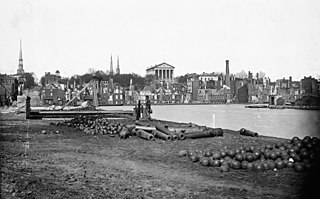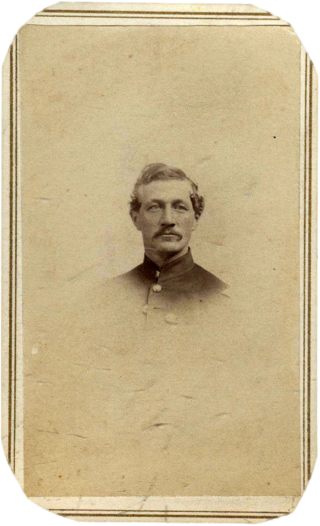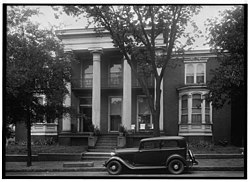
The Tredegar Iron Works in Richmond, Virginia, was the biggest ironworks in the Confederacy during the American Civil War, and a significant factor in the decision to make Richmond the Confederate capital.

Chatham Manor is a Georgian-style mansion home completed in 1771 by farmer and statesman William Fitzhugh, after about three years of construction, on the Rappahannock River in Stafford County, Virginia, opposite Fredericksburg. It was for more than a century the center of a large, thriving plantation and the only private residence in the United States to be visited by George Washington, Thomas Jefferson, Abraham Lincoln, and Dwight D. Eisenhower.

William H. Cabell was a Virginia lawyer, politician, plantation owner, and judge aligned with the Democratic-Republican party. He served as a Member of the Virginia House of Delegates, as Governor of Virginia, and as a judge on what later became the Virginia Supreme Court. Cabell adopted his middle initial in 1795—which did not stand for a name—to distinguish himself from other William Cabells, including his uncle, William Cabell Sr.
Cobb's Legion was an American Civil War Confederate States Army unit that was raised from the state of Georgia by Thomas Reade Rootes Cobb during the summer of 1861. A legion in the Civil War usually meant a combined-arms unit, consisting of two or three branches of the military: infantry, cavalry, and artillery. When it was originally raised, the Georgia Legion comprised 600 infantrymen in the infantry battalions, 300 cavalry troopers in the cavalry battalions, and 100 artillerists in a single battery. The legion concept was not practical for Civil War armies and, soon after Robert E. Lee took command of the Army of Northern Virginia on June 1, 1862, the individual elements were assigned to other units.

James Dearing was a Confederate States Army officer during the American Civil War who served in the artillery and cavalry. Dearing entered West Point in 1858 and resigned on April 22, 1861, when Virginia seceded from the Union. Dearing was mortally wounded at the Battle of High Bridge during the Appomattox Campaign of 1865, making him one of the last officers to die in the war. Despite serving as a commander of a cavalry brigade and using the grade of brigadier general after he was nominated to that grade by Confederate President Jefferson Davis, Dearing did not officially achieve the grade of brigadier general because the Confederate Senate did not approve his nomination. His actual permanent grade was colonel.

William Ransom Johnson Pegram, known as "Willie" or "Willy", was an artillery officer in Robert E. Lee's Confederate Army of Northern Virginia during the American Civil War. He was mortally wounded in the Battle of Five Forks. He was the younger brother of Confederate General John Pegram, who was also killed in action. His grandfather, John Pegram, was a major general during the War of 1812.
Alexander Brown was a Confederate soldier and American merchant, best known as the author of several books on the early history of Virginia.

Richmond, Virginia, served as the capital of the Confederate States of America during the American Civil War from May 8, 1861, before that date the capital had been Montgomery, Alabama. Besides its political status, it was a vital source of weapons and supplies for the war effort, as well as the terminus of five railroads, and as such would have been defended by the Confederate States Army at all costs.

The 1st West Virginia Cavalry Regiment served in the Union Army during the American Civil War. Although it started slowly, it became one of the most active and effective of the West Virginia Civil War regiments—and had 14 Medal of Honor recipients, the most for any West Virginia regiment during the war. It was originally called the 1st Virginia Cavalry, not to be confused with the Confederate 1st Virginia Cavalry. Some reports added "Union," "Loyal" or "West" when identifying this regiment. After the Unionist state of West Virginia was officially admitted to the Union in 1863, the regiment became the 1st West Virginia Cavalry Regiment. The National Park Service identifies it as the 1st Regiment, West Virginia Cavalry.

William Daniel, Jr. was an American slaveowner, lawyer, legislator and jurist who served on the Virginia Supreme Court of Appeals, that state's highest court, from 1846 to 1865.

David Gregg McIntosh was a Confederate artillery officer during the American Civil War from the state of South Carolina.
Willis J. Dance (1821-1887) served as a Confederate artillerist in the American Civil War.
Allen Sherrod Cutts was a Mexican-American War veteran who served as a colonel of artillery in the American Civil War, fighting for the Confederacy.

The 1st Virginia Infantry Regiment was an infantry regiment raised in the Commonwealth of Virginia for service in the Confederate States Army during the American Civil War. It fought mostly with the Army of Northern Virginia.

The 12th Virginia Infantry Regiment was an infantry regiment mostly raised in Petersburg, Virginia, for service in the Confederate States Army during the American Civil War, but with units from the cities of Norfolk and Richmond, and Greensville and Brunswick counties in southeastern Virginia. It fought mostly with the Army of Northern Virginia.

James Adams Cunningham was a volunteer officer in the Union Army during the American Civil War.

Wilfred Emory Cutshaw was an American engineer and Virginia Military Institute graduate, who during the American Civil War rose to the rank of lieutenant colonel in the Confederate Army, then rebuilt Richmond, Virginia, during 34 years as city engineer of the state capital.
Robert Calhoun Burkholder was a Virginia architect, Confederate soldier, and one of Campbell County, Virginia's three delegates in the Virginia General Assembly when it resumed after Congressional Reconstruction (1869-1871).

The 1st Rockbridge Artillery was a light artillery battery in the Confederate States Army during the American Civil War.
Sidney Smith Baxter was a Virginia lawyer who served as Attorney General of Virginia from 1834 until 1852, and who later worked as a commissioner for the Confederate Secretary of War investigating claims of political persecution, particularly in the Commonwealth's western regions.

















